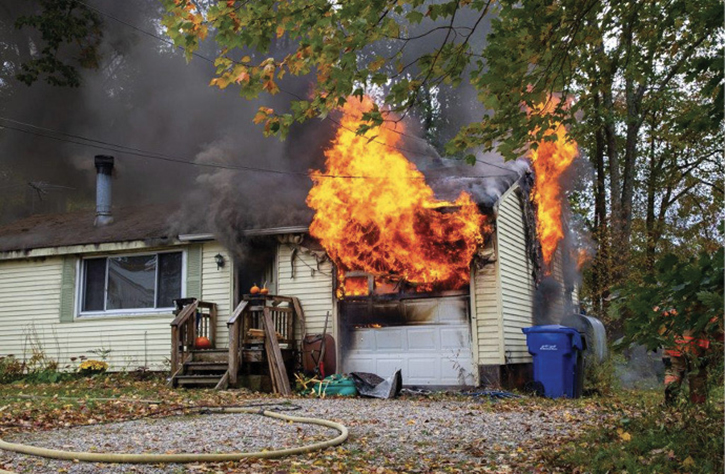
FIRE FOCUS ❘ By BILL GUSTIN
In October 2019, a fire occurred in a single-story, single-family dwelling in the small town of Bolton, Connecticut—a largely rural, heavily wooded area without hydrants. The electric service wires from the pole in the street to another pole down the long driveway arced after a supply line had been laid (photo 1). Household electric service wires typically consist of two insulated 110-volt wires wrapped around a noninsulated cable.
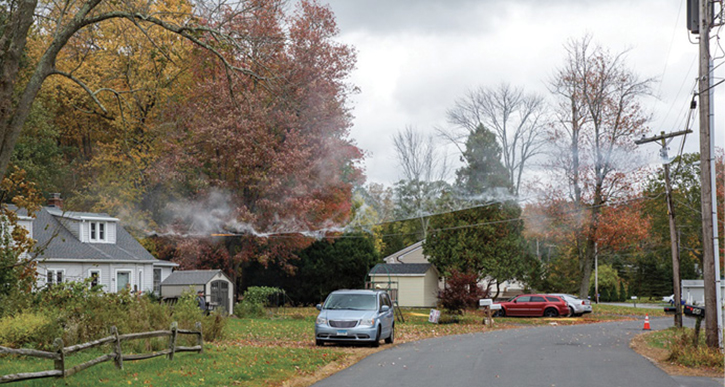
(1) Photos by Patrick Dooley.
The night before the incident, a storm with high winds brought down several power lines. As a result, the electrical utility company was still making repairs in the area at the time of the fire. It appears that a fire had started in the circuit breaker panel located in a stud bay (the space between studs in a wood-frame wall) behind the electric meter at the “delta” side of the house (photo 2). Additionally, the meter was near a 275-gallon heating oil tank. These facts may lead readers to conclude that the fire was caused by an energized neutral, but most of us are not qualified to determine this.
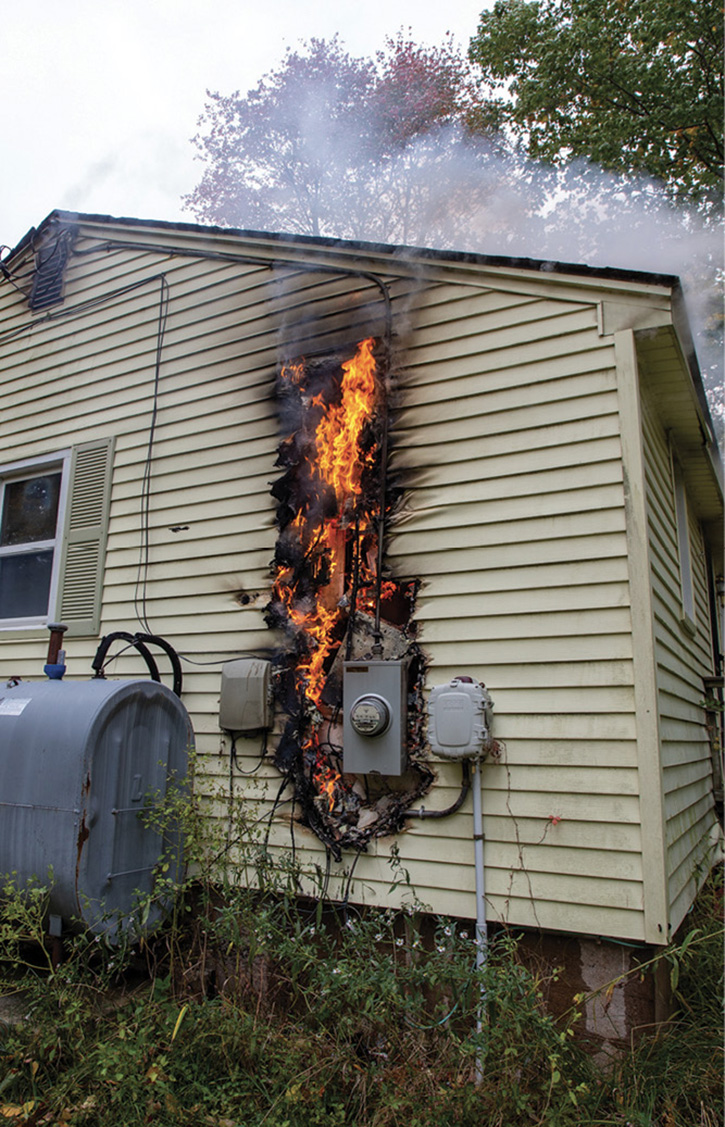
(2)
In consultation with fire investigators, utility company linemen, electricians, and electrical inspectors, I learned that the fire could have been caused by a combination of factors such as an energized neutral, a faulty ground, or inadequate overcurrent protection (but this is purely supposition). Fire officers investigating electrical fires are cautioned not to step outside of the boundaries of their qualifications. (When the article photos were examined by an experienced fire investigator, he advised that the cause of the fire was “accidental/electrical.”)
When I asked why he wouldn’t be more specific, he said he wasn’t qualified to make a more definite determination because he could end up being embarrassed by someone with much higher qualifications. For example, after a large-loss fire in a commercial building, when the cause is suspected of being electrical, the owner’s insurance company may hire an electrical engineering firm that specializes in electrical fire investigations. Their purpose is to see if a third party caused the fire, such as the electrical utility company, an electrical contractor, or a manufacturer of switchgear or electric-powered equipment. This investigation usually results in a lawsuit, with fire department investigators being subpoenaed, their fire cause determination and qualifications put under a legal microscope.
Apparatus Positioning, Water Supply, and the Initial Attack Hoseline
For this incident, the fire building was behind another house that was closer to the road and accessed by a long, narrow driveway (photo 3). The first-arriving engine dropped its four-inch hose on the road and forward laid a supply line down the driveway to the fire; this is a perfect example of intelligent rural firefighting. Had the first-arriving engine not laid its supply line in from the road, it would have had to wait for another engine to arrive; “back down” the long, narrow driveway; drop a supply line; and “lead out” (reverse lay) back to the road. A worse alternative would have the tanker/water shuttle operation conducted at the fire scene, requiring large apparatus to maneuver down the driveway, turn around in very limited space, and maneuver back up the driveway to the road.
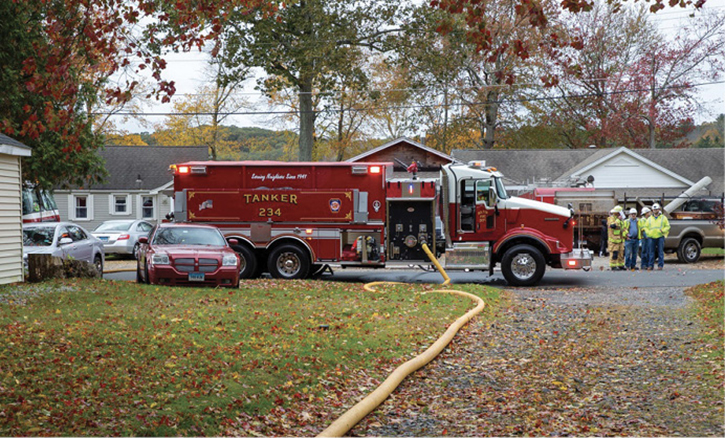
(3)
When laying a supply line in a narrow driveway, have firefighters walk behind the apparatus to pull the line to the side; this will allow other apparatus to get to the scene without risk of driving over the supply line and getting it caught between their dual rear wheels. Here, the first-arriving engine was careful not to position under the electrical service wires. Even when service wires are not anticipated as a threat, they can eventually burn off a structure and fall onto apparatus; metal fences; personnel; and hoselines, which, at this fire, they eventually did.
When service wires burn off a structure, they remain energized because they are still attached to a utility pole. The incident commander (IC), anticipating a working fire, proactively requested a mutual-aid tanker assignment to include six tankers from neighboring volunteer departments (photo 4).
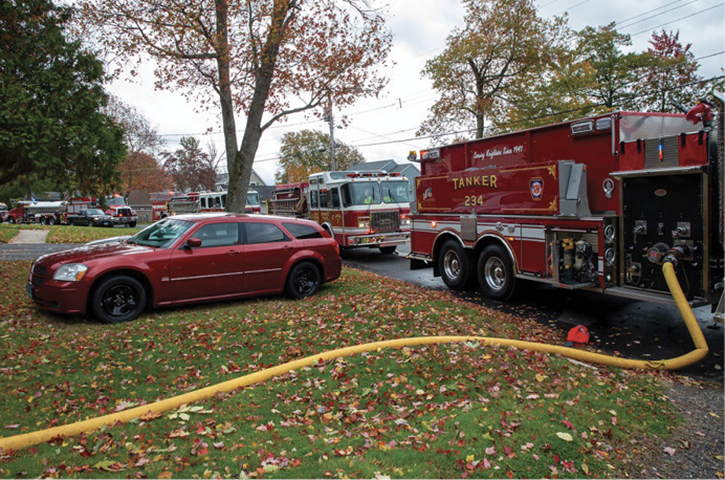
(4)
His reasoning for proactively requesting additional resources was that (1) this fire occurred during the work day and, consequently, he was unsure of how many volunteer firefighters would turn out; (2) there were no hydrants in the area; (3) the fire involved an electrical panel in a wall stud bay, making this a structure fire—not just a room-and-contents fire (a fire in an electrical panel has an express route to the attic; any inherent fire stopping provided by a top plate in platform frame construction would be violated wherever wiring enters the attic); and (4) this was a heavily wooded area, so there was an interface concern.
The initial attack hoseline was stretched to the front door (photo 5). Notice that the backup firefighter is arranging the hoseline in an “S” configuration so that the nozzle and the first 50 feet of hose are brought to the front door, ensuring the hose can be advanced rapidly with a minimum of personnel and that the 50 feet of hose is sufficient to reach any portion inside the house and is readily available.
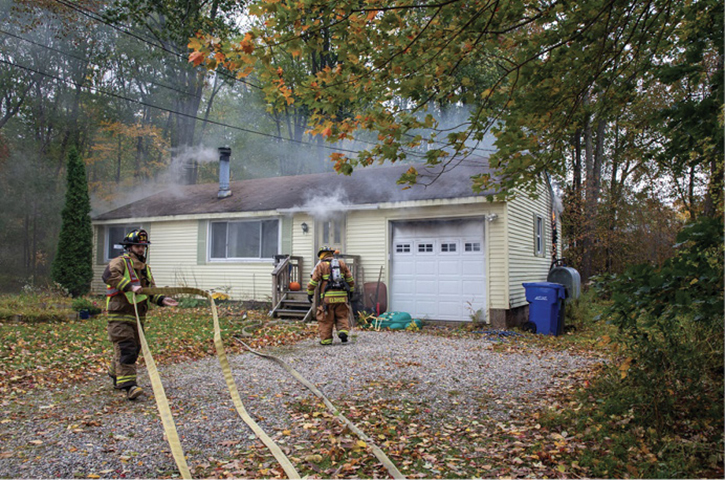
(5)
Use a Transitional Attack?
For this incident, initiating a transitional fire attack—in this case, an exterior attack at the delta side—was an option, but it would not have been appropriate at this stage of the operation because the charged hoseline would have to be repositioned to enter the front door. However, if the hoseline stretched past the meter to reach the front door or a security gate delayed forcible entry and fire attack, then a transitional attack would have been indicated. The objective of the first attack hoseline is to isolate the fire, protecting the rest of house and making conditions better for occupants and safer for firefighters conducting a primary search.
When stretching hose to the front door, bring the coupling of the first 50-foot section to the top landing of the porch to keep it from snagging on stair treads. At the time of this fire, there were no occupants home except for the family dog (photo 6), which was found in a cage and rescued by firefighters performing the primary search. Do not downplay rescuing pets as “no big deal” because it IS a big deal to the family. There are three reasons why it is important to rescue pets: (1) Pets are beloved family members; (2) if a dog is purebred, it can be very expensive; and (3) the most important reason—finding a pet requires the same search techniques used to find a small child.
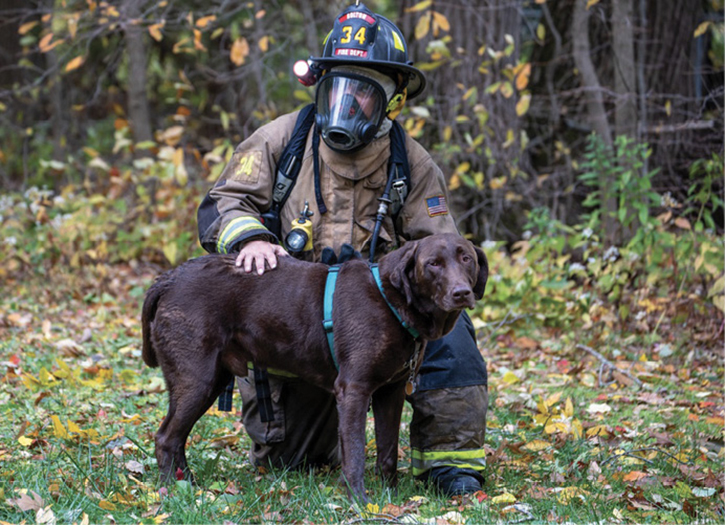
(6)
The hoseline was then advanced through the front doorway to a utility room between the kitchen and the attached garage, where the circuit breaker panel was located (photo 7). Heavy fire was then encountered in the utility room and the garage. The steam is a welcome sight for any IC because it indicates that firefighters are getting water on the fire.
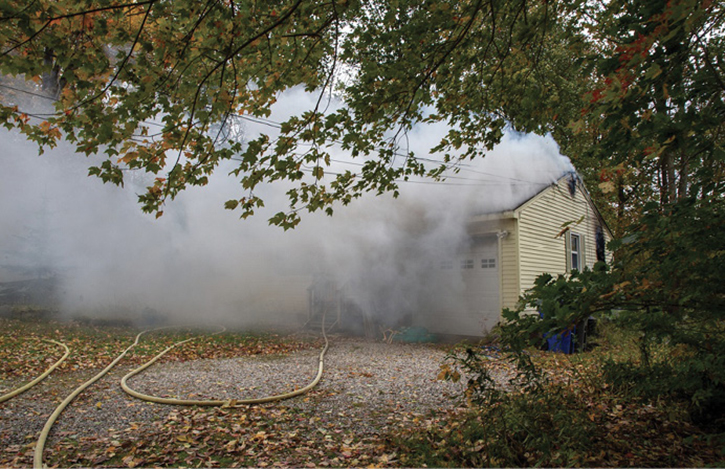
(7)
The Threat of Electrical Shock
Readers who question the wisdom of attacking a fire involving an energized electrical panel before waiting for the utility company to cut the power must read Dr. Vyto Babrauskas’ article “Water Streams, Power Lines, and Shock: How Serious a Hazard?” (Fire Engineering, February 2019). In his article, Babruskas examines research that documents how a firefighter’s fear of applying streams to energized electrical equipment is largely unrealistic, especially if he avoids the use of straight or solid streams. According to Babruskas, “Education concerning the actual hazards of electrical shock is evidently very limited in the fire service, and it is, unfortunately, too common to find that the incident commander (IC) would let a building burn to the ground based on a fear of electric shock in circumstances in which no realistic opportunity for shock is present.”
This is not to suggest that firefighters directing streams on or near energized wiring and switch gear are not at risk of shock, but this risk is largely because of inadvertent contact with their bodies through a metal tool or aluminum ladders. I have been shocked when kneeling in standing water that was in close contact with energized wiring. Similarly, an electrical panel that is unintentionally filled with water from hoselines can become energized and shock anyone who contacts it.
Ventilation Timed with Fire Suppression
As the incident progressed, a firefighter who was assigned to outside ventilation prepared to take the window closest to the fire (photo 8), but he did not break the glass until the operations officer was assured that there was water on the fire.

(8)
This practice is consistent with modern fire research that teaches firefighters that a modern American household is filled with contents and furnishings made with petroleum-based petrochemicals that burn with a voracious appetite for oxygen, thus becoming fuel-rich with flammable fire gases and ventilation limited. Modern research has also taught that ventilation without fire suppression will intensify a fire because of introducing additional oxygen.
A Second Hoseline to the “Charlie” Side
Next, firefighters stretched a second hoseline to the rear or ”Charlie” side (photos 9, 10). It is this fire department’s standard operating procedure to stretch its second hoseline to the rear at residential structure fires; at this fire, it paid huge dividends. The fire momentarily reintensified as the steam from the initial attack dissipated, but the fire was still rapidly suppressed (at least for the time being) (photos 11, 12).
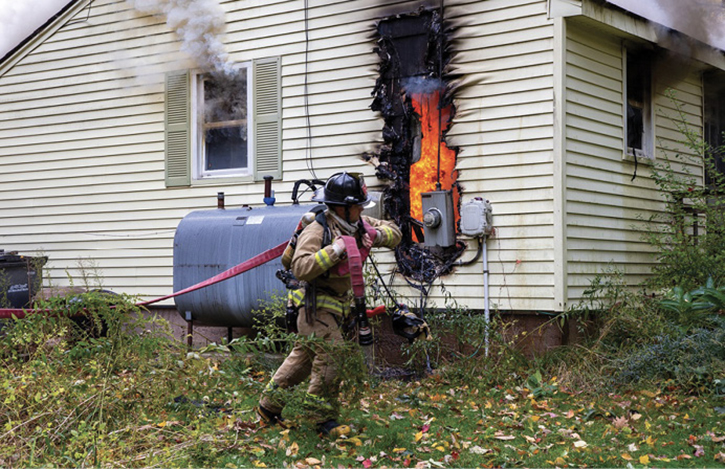
(9)

(10)

(11)

(12)
Note that firefighters then disabled the self-closing device so that the screen door opened completely and did not interfere with the hose advance (photo 13). All too often, screen doors get in a firefighter’s way. An alternative to disabling the self-closer is to remove the door entirely, which can be done by inserting an ax blade between the hinge side of the door and its jamb or inserting a halligan adz vertically in the space and rotating the tool 90°.

(13)
Fire Extension to the Garage and Attic
Conditions deteriorate as flames vent from the window of the attached garage and an attic gable vent (photos 14, 15). Next, the initial attack hoseline has been withdrawn from the house (photo 16) and its stream is directed from the exterior through the row of windows at the top of the garage overhead door (photo 17). Readers may express the concern of an exterior stream pushing fire in the garage onto firefighters who are advancing their hoseline though the rear door.
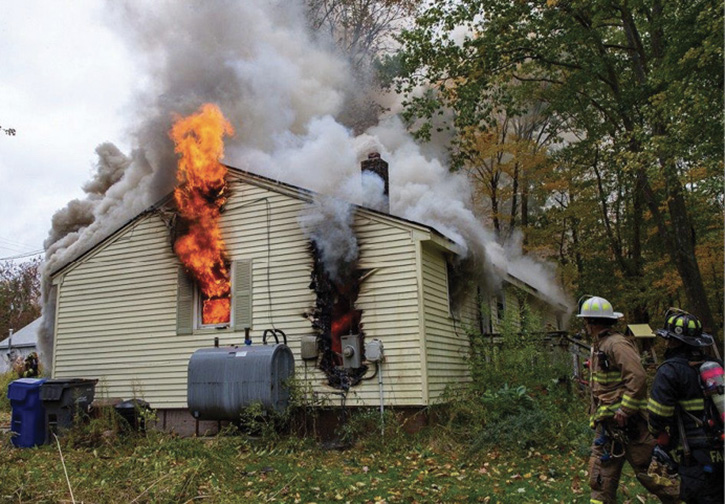
(14)
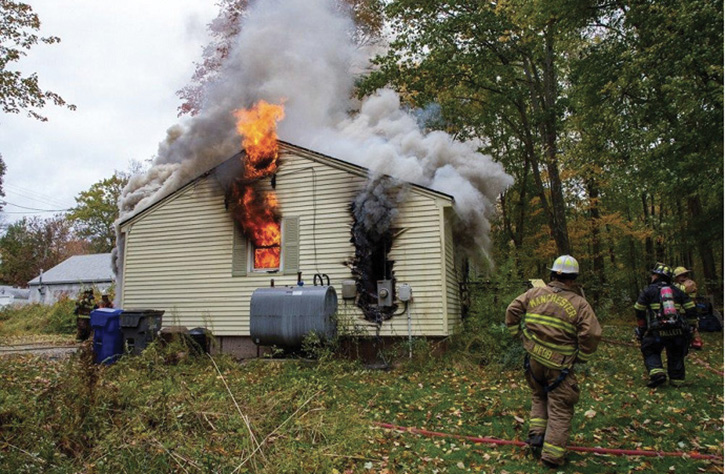
(15)

(16)

(17)
This fear is effectively disproven in a video produced by the Bureau of Alcohol, Tobacco, Firearms and Explosives (ATF) Research Laboratory and presented by fire protection engineer Adam St. John (https://www.youtube.com/watch?v=fIjOGCAZfgk). In the video (at the 48-minute mark), researchers dismantled a large wood deck attached to the rear of a home scheduled for demolition and used the lumber to build a large fire in the attached garage. The researcher’s intention was to direct a fog stream from the exterior into the open garage overhead door and push it into the house through an open doorway between the kitchen and attached garage. However, the experiment was not successful because as soon as the fog stream was directed into the garage, fire conditions rapidly improved, and the fire that did extend to the kitchen from the garage was suppressed rapidly.
Electrical Service Wires Fall
Next, the electrical service wires fell onto the hoseline at the front of the house and burned a hole in it (photo 18). With the hoseline at the front of the house taken out of operation, the fire further intensified (photo 19).
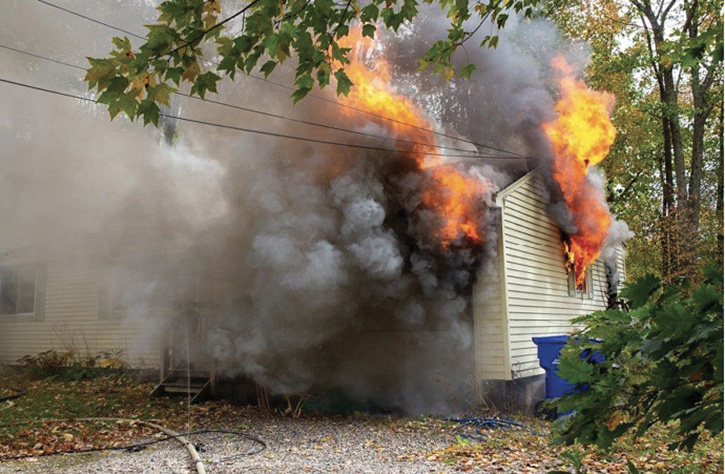
(18)

(19)
Then, interior crews were withdrawn, and firefighters advanced a 2½-inch line through the “D” side window and gable vent to knock down the bulk of the fire, eventually gaining an upper hand on it (photo 20). Firefighters then reentered the building, advancing a second hoseline to the rear to finish extinguishing the fire in the garage and utility room (photo 21).
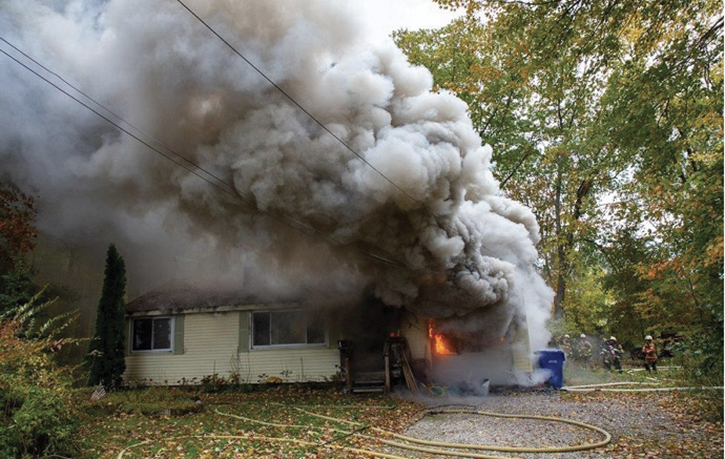
(20)
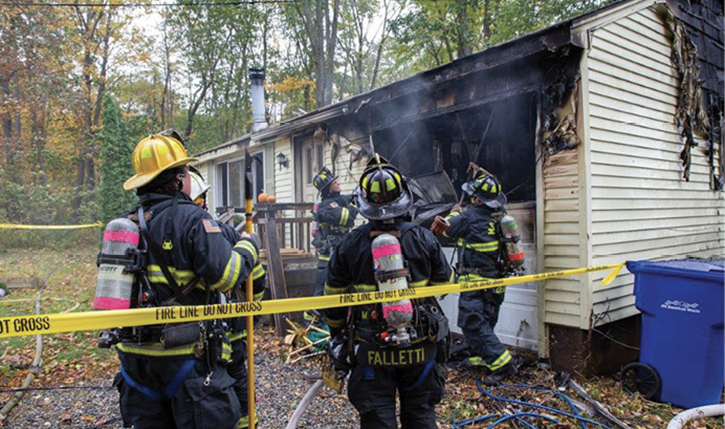
(21)
Lessons Learned/Reinforced
Following are several lessons learned at this incident:
- The fire was attacked aggressively without waiting for verification that the power had been cut.
- The IC understood the potential for this fire to “get away” from them and, therefore, proactively called for a mutual-aid tanker assignment
- The first-arriving engine laying in its own supply line from the road avoided a delay for another engine to lay a supply line as well as a tanker/water shuttle operation at a congested fire scene with very little space to maneuver apparatus.
- The department’s procedure of stretching the second hoseline to the rear truly paid off when the service wires fell on the hoseline operating in the front, taking it out of service.
- The operations officer had no concern that the stream directed in the garage door windows would “push” fire on the crews advancing hose through the back door. This is consistent with the aforementioned tests conducted by the ATF.
- Although there was no indication that occupants were home, firefighters performed an aggressive primary search, resulting in the rescue of the family dog. Do not downplay the significance of rescuing pets because it IS a big deal to the family.
BILL GUSTIN is a 47-year fire service veteran and a captain with the Miami-Dade (FL) Fire Rescue Department. He began his fire service career in the Chicago area and conducts firefighting training programs in the United States, Canada, and the Caribbean. He is a lead instructor in his department’s officer training program, is a marine firefighting instructor, and has conducted forcible entry training for local and federal law enforcement agencies. He is an editorial advisory board member of Fire Engineering and an advisory board member for FDIC International. He was a keynote speaker for FDIC International 2011.

